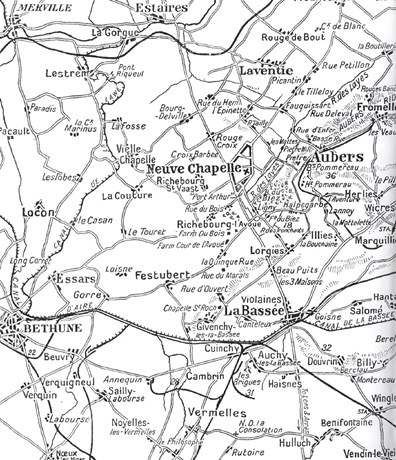Absolution at Aubers : May 1915
- Home
- World War I Articles
- Absolution at Aubers : May 1915
Although the Battle of Neuve Chapelle in March 1915 had given grounds for optimism, in the weeks following this battle, the Allies had been frustrated in their plans. First of all, the Gallipoli landings had not gone to plan, and stalemate was setting in on this front. Virtually simultaneously to the amphibious attack in the Dardanelles, the Germans had launched a surprise attack at Ypres, using poison gas as a weapon. In this fighting, the newly arrived 1st Canadian Division had helped stabilise the line. Although the regulars of the BEF in France and Belgium had been reinforced by the first Territorial Divisions, artillery ammunition in particular was in short supply. Further bad news arrived in early May with the sinking of the liner, the Lusitania, off the coast of Ireland.
Allied planning for a renewal of the Neuve Chapelle offensive had started as early as March, the concept being for the French to take the heights of the Lorette spur at Souchez. It was also planned that the French would capture Vimy Ridge whilst British and Indian troops would be used in support 15 miles to the north, towards the Aubers Ridge; unlike Vimy, this was a barely discernible rise in the ground. The British would be attacking over the same area as they had in March.
Above: The Aubers area. Click here to view a more detailed map of the area (or click on the image above to see it in more detail)
As the area below the Aubers Ridge was flat with a high water table, rather than trenches, both sides had built breastworks. The British attack in March had revealed to the Germans that their breastworks needed strengthening, and they had set about this task immediately. Extra belts of barbed wire were installed and the breastworks were reinforced to some 20 feet in thickness. Crucially, machine guns were also installed in embrasures in the breastworks - which were sited so as to sweep across No Man's Land. Behind the front lines the Germans built concrete bunkers which would be strong points in case of a British breakthrough.
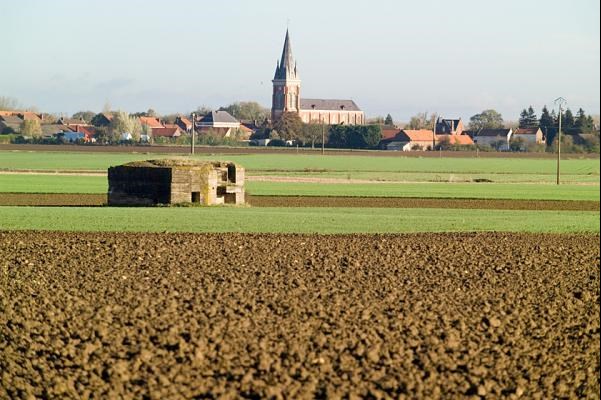
Above: The remains of German Pill Boxes are still to be found on the Aubers Ridge.
The plan was for two attacks to be made as a pincer movement. The southerly assault would be made in an eastwards direction from the area known as Port Arthur (close to Neuve Chapelle village) - this by the Indian Meerut Division and the 1st Division. The other pincer attack was to be made some four miles to the north and would be made by the 8th Division with the objective of capturing the German line southwards from the village of Fromelles.
Absolution
One of the units of the 1st Division was a battalion raised in Ireland, the 2nd Royal Munster Fusiliers. Commanded by Lt-Col Victor Rickard, the battalion war diary records:
"8th May - Left billets at 7.15. On the road at the first halt Father Gleeson gave absolution. Battalion relieved the Coldstream Guards... prior to assaulting German trenches."

Above - Lt Col VGH Rickard. Image courtesy of www.royalmunsterfusiliers.org
Father Gleeson was the battalion's padre. He recorded:
"We march out .... about 900 strong, our Commanding Officer being Major Rickard and the Adjutant, Captain Filgate - two of the kindliest men I have come across. We leave about 7pm. The scenes of enthusiasm are outstanding. I ride my horse. Give Absolution to the battalion during rest on road.... The men all sing hymns 'Hail Great St Patrick'. I go further up - near the trenches and bid good bye to all. So Sad!"
The event was recorded in a painting created by Fortunino Matania in the 1920's. This painting, commissioned by Mrs Jessie Louisa Rickard, shows Father Gleeson giving the absolution with Lt Col Rickard also on horseback just beyond Fr Gleeson.

Above: The Last General Absolution of the Munsters at Rue du Bois. Originally published in The Sphere 27 November 1916, the original was destroyed during the 'Blitz' of London in the Second World War.
Father Gleeson
On the outbreak of the war, Francis Gleeson was a 30 year old priest working in a home for the blind. He volunteered to serve as a chaplain on the outbreak of war and was sent to join the 2nd Royal Munster Fusiliers, who in joined in the first weeks of the war. Robert Graves in his memoir Goodbye To All That states he temporarily took charge of the battalion in 1914 when all officers became casualties, although this claim is considered to be fanciful.
Nevertheless, Gleeson's war service was highly commendable. In his diary he noted, after the Battle of Aubers Ridge:
“I got 12 letters today; just after reading them. What answering they will take tomorrow. I like to give these poor people all the solace I can, anyhow, but still there’s no limit to the sorrowing inquiries. The tragedy of these letters....One letter was from a broken-hearted girl... Then, the mothers! Oh!”

Above: A certificate issued by Gleeson to certify attendance at his battalion mission. This document was issued to Jeremiah Fittzgerald , 4409 of the 2nd RMF in July 1915. The text in the top right corner of the certificate says "Rue du Bois" - this being the area where the Munsters attack in the Battle of Aubers Ridge.

Above: Gleeson as a young priest (Image courtesy of faithinwartime.wordpress.com )
Preparation for the Battle
Elsewhere, the men of the attacking battalions were briefed by their commanding officers. In the "northern attack" one of the battalions was the 2nd Scottish Rifles; a photographic record of the hours before they assaulted is available in the Imperial War Museum.
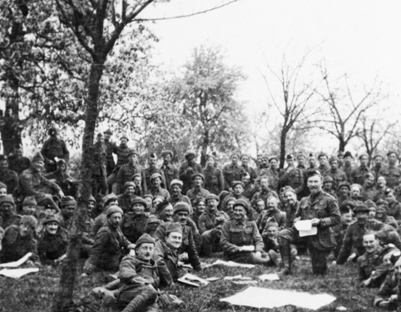
Above: Following a meeting of battalion commanders at 23rd Brigade HQ, Lt-Col C B Vandeleur briefs the 2nd Battalion, Cameronians (Scottish Rifles), on their role in the forthcoming attack. At this time the battalion were in billets at Rue de Bois. (Image courtesy of the Imperial War Museum. IWM Q51622.)
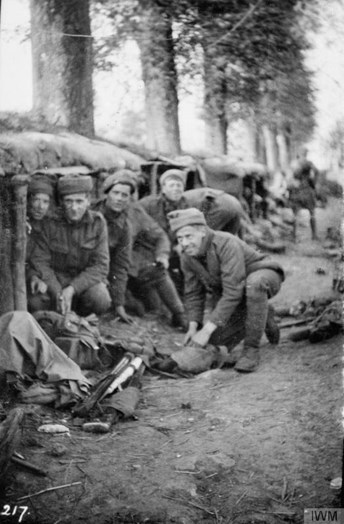
Above: Men of the 2nd Battalion, Cameronians (Scottish Rifles), preparing battle kit outside a dugout behind Cellar Farm at 5.15am on 9 May 1915. (Image courtesy of the Imperial War Museum. IWM Q51623.)
The Attack Begins
At 5am the British artillery opened up. This was not as intense as had been managed at the Battle of Neuve Chapelle due to ammunition shortages. Some of the fire was said to have fallen short - this was caused by barrel-wear on the guns. After an intensification of the bombardment at 5.30am, the infantry attacked. Although some of the attacking troops managed to break into the German lines in the northern attack, this was an isolated success and generally the attack broke down at an early stage. Some men were seen to be retiring, having received a verbal order, at the same time German prisoners being shepherded to the rear were mistaken for a counter attack. In among this confusion was Brigadier-General Arthur Lowry Cole, who - with his staff - was attempting to restore order. Bravely - or foolishly - Lowry Cole stood on the parapet in an attempt to restore order and was hit and mortally wounded.
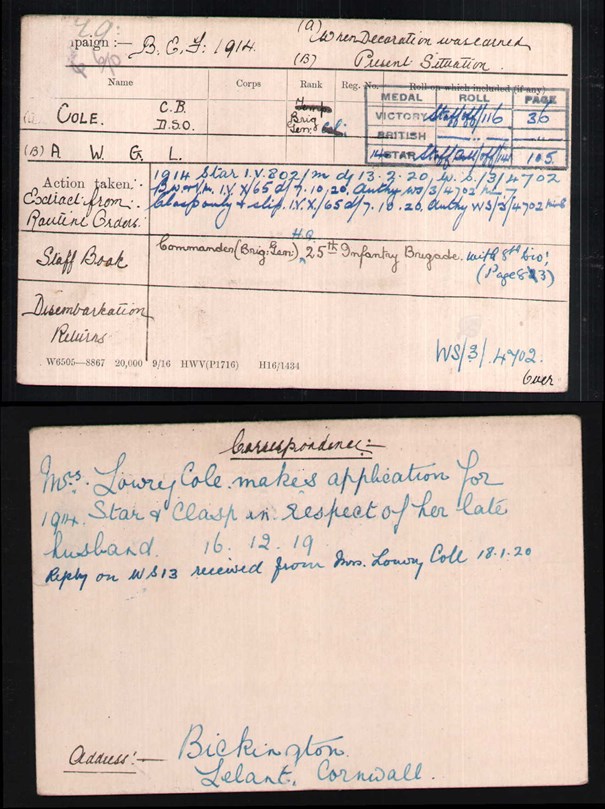
Above: The Medal Index Card of Brigadier-General Lowry Cole. These cards were saved by the WFA some years ago
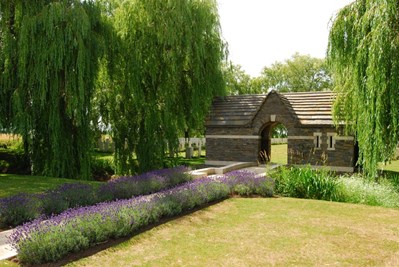
Above Brigadier-General Lowry Cole is buried at arguably one of the Commission's most stunning locations, Le Trou Aid Post Cemetery.
The heaviest fatalities in this northern attack fell on the 2nd Rifle Brigade, which lost over 250 officers and men killed. Other battalions suffered heavy losses, with almost 200 officers and men killed in the 1st Royal Irish Rifles. The vast majority of these men are commemorated on the Ploegsteert Memorial in Belgium. (Unusually, for a single day's action the commemorations are divided between two memorials to the missing. The men with no known grave who were killed in the Northern attack are commemorated on the Ploegsteert Memorial, but those in the southern attack are name on Le Touret Memorial to the Missing. )
In the southern attack, there was virtually no success at all. The 2nd Battalion Royal Sussex Regiment lost over 270 officers and men killed, and the 1st Battalion Northamptonshire Regiment suffered over 260 fatalities. Casualties were nearly as heavy in many other battalions, with the 2nd Battalion Royal Munster Fusiliers suffering over 150 dead, including Lt Colonel Rickard.
Lt Col Rickard's body was found and was originally buried at Edward Road Cemetery Number 2. This cemetery one of a group of "Edward Road" Cemeteries (numbering at least five) that were in the nearby village of Richebourg l'Avoué. The men buried in Cemetery Number 2 were re-interred in the early in about 1924. Ten identified Indian soldiers were re-buried in an Indian plot at Rue-du-Bacquerot No 1 Military Cemetery , but the majority of the men originally buried in this small cemetery (twenty of whom were identified and were known to be killed on 9 May 1915) were re-interred in Cabaret-Rouge British Cemetery at Souchez.
Aubers Ridge: The aftermath
Aubers Ridge cannot be regarded than anything other than a very costly failure. Despite renewing the attack in the afternoon, no ground was taken and it is unlikely the attack assisted the French army in their efforts to the south. On 9 May casualties amounted to over 11,000 with nearly 4000 fatalities on the day and dying of their injuries in the following days.
Sir Douglas Haig, in his private papers, wrote:
The defences in our front are so carefully and so strongly made ... that in order to demolish them a long methodical bombardment will be necessary by heavy artillery (guns and howitzers) before Infantry are sent forward to attack.
It is likely that this conclusion set the tone for the British Army's tactical outlook for at least a year.
Article by David Tattersfield
Further Reading
Aubers Ridge 9 May 1915: The Unpleasant Truth
Aces Low: The Wimbledon Champion at Aubers
Video Resources
There are two excellent videos on the WFA's Youtube channel featuring Spencer Jones
Harsh Realities: The BEF's offensives of 1915
Toothless Lions - The Royal Artillery and the Firepower Crisis of 1915






